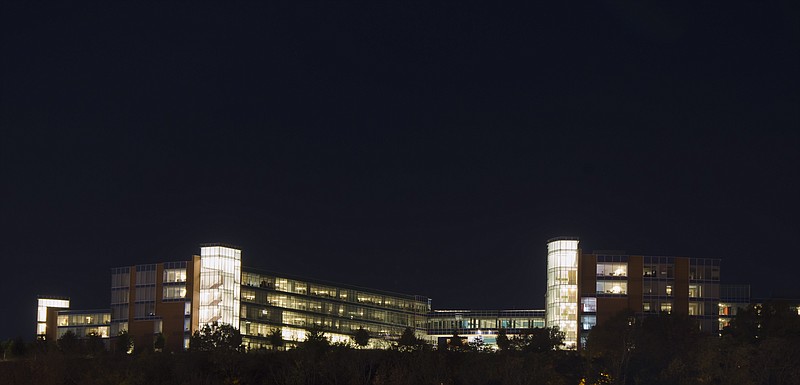BlueCross BlueShield increased its membership and revenues to record highs last year, helping Tennessee's biggest health insurer to boost its Chattanooga staff above 5,000 workers for the first time and regain an operating profit in 2017 after suffering an operating loss the previous year.
Although BlueCross still lost $103 million last year from individual plans offered under the health care exchanges of Obamacare, the Chattanooga-based insurer made enough net income from its commercial group insurance, TennCare and Medicare business to end 2016 in the black. BlueCross reported net income last year from all operations of $118 million, including $41.9 million in investment income from its $1.9 billion in statutory reserves.
"These results show the value and importance of having different lines of business and adequate reserves to handle unforeseen circumstances," said Roy Vaughn, senior vice president of communications for the Tennessee BlueCross plan. "In 2016, we performed very well from an operations standpoint, and I think the increase in business and membership shows that Tennesseans recognize the value of our services."
Vaughn said BlueCross enrollment in Tennessee rose 3 percent last year to a record high.
Nonetheless, BlueCross still suffered losses for its third consecutive year in the individual health exchange market, bringing the company's total losses in the individual policy market during the first three years of Obamacare to $414 million - even as BlueCross raised its individual rates by 19 percent in 2015 and 36 percent in 2016.
In response to such losses, BlueCross withdrew its individual coverage in the state's three biggest markets this year - Memphis, Nashville and Knoxville - and implemented an average 62 percent rate hike for those still in the plan in Chattanooga and 57 smaller counties. Vaughn said initial results indicate that BlueCross should do much better in 2017 in the individual market, although BlueCross CEO J.D. Hickey has hinted that additional rate hikes may be needed for 2018 due to ongoing uncertainties about the future of Obamacare and the individual exchange market.
BlueCross did agree to return service to Knoxville next year after Humana decided to withdraw from the 16-county Knoxville market and potentially leave the state's third biggest city without an individual insurer for 2018.
"We can't justify doing so based solely on current political uncertainty, but instead we believe it is an extension of our mission to serve our fellow Tennesseans, especially those who do not have other options for coverage," Hickey said in his letter to the Tennessee Department of Commerce and Insurance.
Although net income improved overall for BlueCross last year, the 0.9 percent profit margin for the insurer was still far below the 2 to 3 percent sought by the nonprofit company to help ensure its growth and stability, Vaughn said. BlueCross' statutory reserves rose to a record high of $1.9 billion. But with 3.4 million persons covered by the Blues in Tennessee, the extra reserves above the state minimum are equal to only 65 days of claims.
Other companies in the health care industry reported profit margins last year ranging from 0.52 percent for hospitals to over 14 percent for pharmaceutical and biotechnology drug companies, according to a study by New York University.
Last year, BlueCross calculates it paid 87 percent of each premium dollar directly to medical providers. The $548 million BlueCross paid in premium, income, property and other taxes last year was more than four times its net income.
Vaughn said BlueCross continued to work last year to encourage its members to get wellness exams and to utilize preventative health care, sending health scorecards to nearly 1 million persons to help encourage them to get their health checked.
Such measures helped BlueCross gain in customer satisfaction ratings among its peers.
In its 2017 ranking of customer satisfaction, J.D. Power ranked BlueCross of Tennessee as the top health insurer in its Southeast region. BlueCross' commercial plan and BlueCare plan also each earned a 4-star rating (out of a 5-star maximum) for 2016 from the National Committee for Quality Assurance (NCQA), an accrediting body for health insurance plans.
"Our 4-star rating is an achievement that our competitors in Tennessee can't claim," said Dr. Andrea Willis, chief medical officer for BlueCross of Tennessee. "This rating shows consumers in a very tangible way that we are dedicated to quality and to helping our members get care that improves health outcomes."
BlueCross, which is already the state's biggest health insurer with more than half of the state's total insured population, gained enough new business last year to swell the company's staff to 6,200 employees, including more than 5,000 in Chattanooga where the company began in 1949. BlueCross also indirectly employs nearly 1,000 more local workers as contractors and support staff to help operate its corporate headquarters, making BlueCross the third biggest employer in Hamilton County behind only Erlanger Health System and Hamilton County Public Schools.
With the gain in income and customer ratings, the BlueCross board boosted the pay for Hickey from $1.6 million in 2015 to $1.9 million in 2016, company spokeswoman Mary Danielson said.
Contact Dave Flessner at dflessner@timesfree press.com or at 423-757-6340.
BlueCross results for 2016
* $13.9 billion - Revenues from premiums and claims handled for self-insured businesses* $76.5 million - Operating income, compared with a $21 million loss from operations the previous year* $1.9 billion - Statutory reserves at the end of 2016, or $216 million more than the state minimum* 118 million - Net income, up from $6 million the previous year* 87 percent - Share of premium dollar spent on direct medical costsSource: BlueCross BlueShield of Tennessee
2016 growth rates
* 3 percent growth in enrollment to 3.4 million covered lives* 8 percent growth in medical services provided* 22 percent increase in taxes paid to $548 million* 54 percent gain in investment income to $41.9 millionSource: BlueCross BlueShield of Tennessee
How premiums are spent
* 26 perrcent for physician services* 25 percent for inpatient hospital care* 21 percent outpatient facility care* 11 percent for prescription drugs* 8 percent administrative costs* 4 percent other medicals services* 4 percent taxes* 1 percent after -tax profitSource: BlueCross BlueShield of Tennessee

